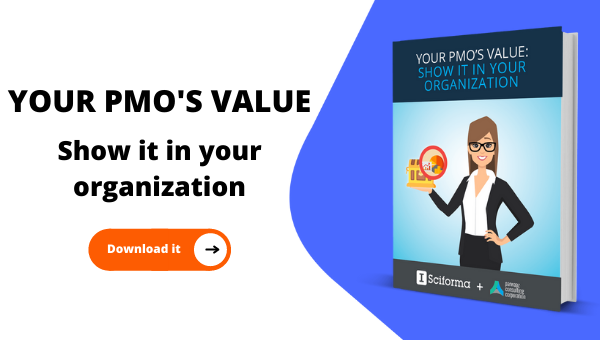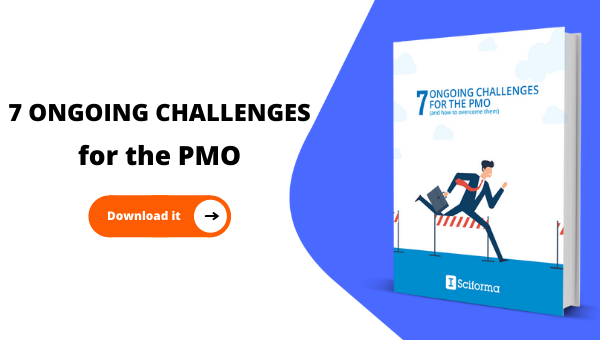It’s not news that the COVID-19 outbreak thwarted or set back many projects and initiatives. We have front-row seats to the ways unexpected events can derail the best laid PPM plans of mice and men.
Setbacks do happen. Negating that fact will certainly not prevent it from impacting you and your portfolio project management (PPM) processes and projects. As a matter of fact, exploring the realm of possible negative scenarios and allowing for unwanted twists and turns can maximize a project’s chances of delivering on its promises. This is because project activity is intrinsically the pursuit of expected rewards and benefits.
Accordingly, PPM requires finding a balance between pessimism and optimism. On the one hand, heady excitement about future prospects is a key driver for project activity. On the other hand, managing expectations and incorporating a consideration of all possible hurdles is a healthy and constructive practice. Most importantly, it will actually increase the chances for projects to hit payback.

PPM: In Pursuit of a Brighter Tomorrow
A project is defined as an activity that is intended to achieve a particular purpose. In other words, any organization or individual who engages in a project does so to yield positive results.
A project always boils down to pursuing future benefits. This is the case whether or not:
- the initiative is about creating something new or improving existing conditions
- the initiative is expected to sustain or further a competitive edge, streamline operations, or pave the way for new activities
- the objectives are quantified goals or more open directions (as is often the case with innovation projects)
- the activity is about space exploration, the creation of a non-profit, the development of a new consumer-facing product, or the extension of a production facility
One only sows the seeds so that one can reap the fruit. Without the bottom line in mind, why bother marshaling resources and investing time and effort into any project?
Project and PPM activity relies on the assumption that the planned or expected benefits (output) outweigh the investment in terms of time, effort, and resources (input) after factoring in the probability of attaining those benefits.
Leaving aside the intricacies of ROI calculations, deciding to launch a project means you are looking into a positive future. One where your PPM vision has come true, and where what could have gone awry hasn’t.
This positive outlook on the future is the cornerstone of the can-do attitude required to successfully complete a project. Without some ingrained belief that things will take a positive turn, without some modicum of faith in the future, who would press ahead with large, ambitious projects?
This fundamentally optimistic stance is also what makes PPM activities so akin to entrepreneurial ventures. Both entail taking a leap into the unknown today in the hope of realizing something positive tomorrow.
In both cases though, hope is just not enough. Happy-go-lucky entrepreneurs usually don’t make the cover of Forbes Magazine, and strokes of luck don’t make for a business plan. Belief in the success of any venture or project should be built on solid grounds — which means preparing for failure.
A Pessimist’s Take on PPM
What could, and can, go wrong? Actually, quite a lot.
The prize is almost never guaranteed. In case you doubted it, just think about the current crisis. Sudden halts in activity can disrupt even the most simple, unlikely-to-derail maintenance projects.
Besides, no one is invulnerable. The proverbial “too big to fail” does not mean that sizable, well-endowed organizations or projects can’t crash just like their more modest counterparts. It only means that they would drag many others down with them, making the cost of failure unbearable. Mammoths, too, exist in the graveyard of evolution. So it is safer to assume that even the largest organizations and initiatives experience mishaps and failure.
The sheer range of factors that may send a project in a tailspin is humbling. The spectrum of possible impediments includes technical issues, de-allocation of earmarked funds, unavailability of critical resources. Further down the road, you might reach the finish line only to find that your product is no longer relevant because a competitor beat you to market. (To take an example that’s on everyone’s mind, consider vaccines.)
However, from a more macro-perspective on external forces that might thwart your initiatives, consider:
- stock market volatility
- cyber threats
- changing consumer expectations
- increasingly prevalent natural disasters
- sudden shifts in regulation (like the July 16, 2020 decision by the Court of Justice of the European Union to invalidate the EU-US Data Privacy Shield, effective immediately)
To spice it up, the consequences can be dire. We are not just talking about your average occasional project overruns.
In fact, let’s consider a couple of real life examples of projects gone wrong, starting with the construction of a new nuclear reactor in Flamanville, France. The works started back in 2007, with completion scheduled for 2012 for an estimated €3.4 billion. Supplier delays in component delivery, a series of back-to-back mechanical and technical problems stoking safety concerns, the discovery of legacy waste buried under the construction site, have all combined to mire the project. At this time, the reactor is scheduled to be commissioned in 2023 at best, for a total cost of €19.1 billion. Meantime, the delay and cost overrun have also jeopardized loan guarantees for other of the company’s projects.
In another vein, director Terry Gilliam’s Don Quixote movie has often been described as a “cursed” project. Gilliam started working on the film in 1989. After a decade of effort to secure funding, production began in 2000—then immediately met a spate of various catastrophes. Flooding destroying equipment, disputes with insurance companies, lead actors diagnosed with terminal illnesses: everything conspired to prevent the movie from seeing the light of day. In 2018, almost three decades after the project’s inception, the film finally concluded. Even so, conflicts with a former producer made the release process yet another struggle, as a result of which the film was only released in five European countries.
These extreme examples shouldn’t discourage anyone, but simply illustrate the fact that problems tend to find their way in. PPM teams would do well to have in mind good old Murphy’s law: “If something can go wrong, it will.”
Reconciling the Best and the Worst of all Possible Worlds
Could some of the above-mentioned situations have been avoided? Possibly. Yours truly is no nuclear scientist or film producer. Some of those issues reek of bad luck and probably were ineluctable. Still, the role of project managers is to plan for problems, risks, and threats to the best of their abilities.
So the question is: how can you juggle the sense of excitement about the future that drives and fuels project activity, with constant vigilance about every possible disaster that could hit you in the head? How do you walk the line between optimism and pessimism?
One answer is to occupy the middle ground: realism.
By taking a grounded approach to identifying and weighing realistic outcomes and risks, project managers can hit that sweet spot between optimism and pessimism.
Managing Expectations
It starts by defining what you can expect realistically. Planning and managing a project is not chasing rainbows or indulging in wishful thinking. The expected outcome should stand an actual chance of coming true without the providential intervention of a deus ex machina. It should also have a direct causal link to the project. Positive knock-on effect does exist, but it is hard to quantify and it involves third parties you have no sway over, so it is usually safer to leave it out of the planning.
Underlying assumptions should also be realistic: they should be justifiable based either on existing conditions, or on logical, documented projections. For example, if a business case starts with “Let’s assume Bitcoin is worth €1m…”, you need to be able to demonstrate why this is likely to happen.
To achieve such clarity, portfolio managers need a solid understanding of the current situation and great visibility.
PPM: Planning for the Foreseeable
Similarly, threat assessment and risk planning should be grounded in a practical approach. Project planners and managers should identify realistic potential issues, assess, measure, and try to quantify. This is a matter of what may or might happen in the future: there are no certainties whatsoever. Yet common sense and a good understanding of existing conditions will help map out the most likely of possible futures.
You can hardly quantify the probability for your planned production site to lie upon an ancient sacred burial ground, or the odds of a killer ant invasion. But film-makers can and do allow for inclement weather conditions, and technology risk is not foreign to nuclear experts. From what you know of your business, line of activity, and market, it is possible to extrapolate an actionable view of what may go wrong.
The good news is that such knowledge accumulates by building libraries of risk models. Portfolio managers can reuse the analyses and insights from previous similar projects — with the obvious caveat that models are updated to reflect new developments and take into account project specifics.
Some project professionals demonstrate a propensity to overestimate and inflate safety margins, just to be on the safe side. While caution is commendable, planning for what might just maybe happen in the worst case scenario will most certainly gnaw away at the value of the project for the business. Again, finding the right dosage is a matter of clarity, of insights into the real world.
Armed with realistic assessments of what can be expected and what can be feared, portfolio managers can consolidate the good, the bad, and the really ugly, and strike the right balance between optimism and pessimism.
Walking the Line
These concerns are not limited to the planning stages of a project. They remain valid throughout the whole cycle. Conditions evolve. Markets fluctuate, consumers in the digital world embrace new usage patterns, competitors don’t just sit on their hands; internally, governance and strategic directions, the organization’s resource pool and toolset, the makeup of portfolios, are all prone to disruption. Change can be sweeping, or less conspicuous — which is sometimes more dangerous because it makes it easier to overlook.
It is crucial to track and monitor ongoing projects, making sure that the initial appraisal of outcomes and the probability for them to materialize are still up to date. Project and portfolio managers should stay poised to revise expectations, to plan for new possible threats as they come into sight, to review the weight factors guiding the decisions.
Again, visibility is the key to sustaining the balancing act between a longing for benefits to come and a wary eye to what may get in the way.
Embracing both the bright side and the dark side may be the best way for PPM professionals to make sure they achieve the desired results. While expectation is the driver for action, risk is inherent to any undertaking.
Incorporating a pessimist’s approach into project planning and management will not stifle the drive to move forward. On the contrary, basing decisions on a solid assessment of possible futures, including grim ones, should spur on the organization to take informed, calculated risks in pursuit of attainable benefits.
After all, to quote Erica Jong: “If you don’t risk anything, you risk even more.”
To learn how a PPM tool can enhance your business visibility, download our…
Suggested resources for more information and insights about agility:
- Why There’s No (Longer) Such Thing as “Business as Usual”
- What Type of Businesses and Organizations Are Using Agile PPM?
- Why You Should Make Sure Your Business Doesn’t Stay Behind the Digital Curve







Benoît Boitard
Benoît has multiple professional experiences, working in particular as a digital strategy consultant, both in emerging start-ups and in large companies. These diverse experiences have imbued him with a global vision of project management in traditional and agile working environments.